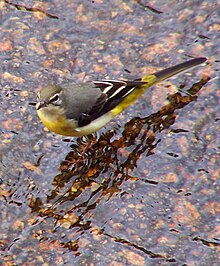Grey wagtail
| Grey Wagtail | |
|---|---|

| |
| Scientific classification | |
| Kingdom: | |
| Phylum: | |
| Class: | |
| Order: | |
| Family: | |
| Genus: | |
| Species: | M. cinerea
|
| Binomial name | |
| Motacilla cinerea | |



The Grey Wagtail (Motacilla cinerea) is a small passerine in the wagtail family Motacillidae, which also includes the pipits and longclaws. Its relationships are not well resolved; while it belongs to the non-African clade of wagtails, these are confusing in their external morphology, and mtDNA cytochrome b and NADH dehydrogenase subunit 2 sequence data is not able to robustly resolve their relationships. While the present species is probably most closely related to Citrine Wagtails and some Blue-headed Wagtails, the exact nature of this relationship is at present undeterminable (Voelker, 2002).
This species breeds in much of temperate Europe and Asia and parts of north Africa. It is resident in the milder parts of its range, such as western Europe, but northern and eastern populations migrates to Africa, South Asia and Papua New Guinea.
This is an insectivorous bird of fast flowing streams, although in winter it will move to slower flowing lowland waters.
It nests in crevices in cliffs and rocks, laying 3-6 speckled eggs.
This is a slender bird, 17-20cm in length, with the characteristic long, constantly wagging tail of its genus. It is the longest tailed of the European wagtails.
The breeding adult male is basically grey above and yellow below, with a black throat. Other plumages lack the black throat, and the yellow may be diluted by white except in the undertail area.
The call is a sharper version of that of White Wagtail.
Gallery
-
In breeding plummage in Kullu - Manali District of Himachal Pradesh, India
-
Breeding Male in Kullu - Manali District of Himachal Pradesh, India
-
at New Alipore, Kolkata, India
-
at New Alipore, Kolkata, India
-
Grey Wagtail in winter grounds at New Alipore, Kolkata, India
-
Adult, Spring, England
-
Juvenile, Spring, England
References
- Template:IUCN2006 Database entry includes justification for why this species is of least concern
- Voelker, Gary (2002): Systematics and historical biogeography of wagtails: Dispersal versus vicariance revisited. Condor 104(4): 725–739. [English with Spanish abstract] DOI: 10.1650/0010-5422(2002)104[0725:SAHBOW]2.0.CO;2 HTML abstract
External links
- Internet Bird Collection: Grey Wagtail videos. Retrieved 2006-NOV-22.
- Madeira Birds: Grey Wagtail







